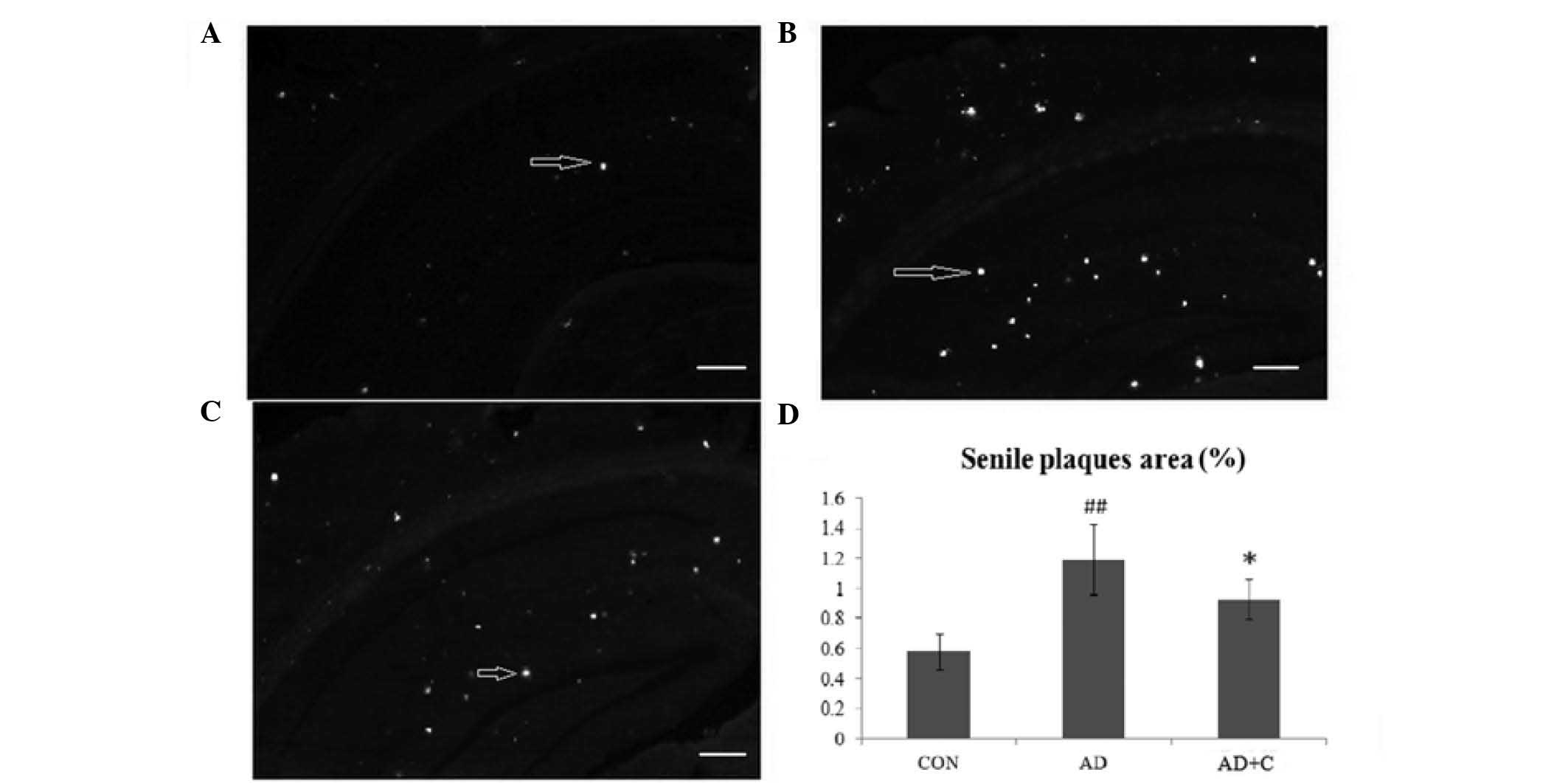|
1
|
Forsyth E and Ritzline PD: An overview of
the etiology, diagnosis, and treatment of Alzheimer disease. Phys
Ther. 78:1325–1331. 1998.PubMed/NCBI
|
|
2
|
Todd S, Barr S, Roberts M and Passmore AP:
Survival in dementia and predictors of mortality: A review. Int J
Geriatr Psychiatry. 28:1109–1124. 2013.PubMed/NCBI
|
|
3
|
Jang BG, In S, Choi B and Kim MJ:
Beta-amyloid oligomers induce early loss of presynaptic proteins in
primary neurons by caspase-dependent and proteasome-dependent
mechanisms. Neuroreport. 25:1281–1288. 2014. View Article : Google Scholar : PubMed/NCBI
|
|
4
|
Henriques AG, Oliveira JM, Gomes B, Ruivo
R, da Cruz e Silva EF and da Cruz e Silva OA: Complexing Aβ
prevents the cellular anomalies induced by the Peptide alone. J Mol
Neurosci. 53:661–668. 2014.PubMed/NCBI
|
|
5
|
Shichiri M: The role of lipid peroxidation
in neurological disorders. J Clin Biochem Nutr. 54:151–160. 2014.
View Article : Google Scholar : PubMed/NCBI
|
|
6
|
Spielman LJ, Little JP and Klegeris A:
Inflammation and insulin/IGF-1 resistance as the possible link
between obesity and neurodegeneration. J Neuroimmunol. 273:8–21.
2014. View Article : Google Scholar : PubMed/NCBI
|
|
7
|
Smemo S, Tena JJ, Kim KH, Gamazon ER,
Sakabe NJ, Gómez-Marín C, Aneas I, Credidio FL, Sobreira DR,
Wasserman NF, et al: Obesity-associated variants within FTO form
long-range functional connections with IRX3. Nature. 507:371–375.
2014. View Article : Google Scholar : PubMed/NCBI
|
|
8
|
Rodríguez-Seguel E, Alarcón P and
Gómez-Skarmeta JL: The Xenopus Irx genes are essential for neural
patterning and define the border between prethalamus and thalamus
through mutual antagonism with the anterior repressors Fezf and
Arx. Dev Biol. 329:258–268. 2009. View Article : Google Scholar : PubMed/NCBI
|
|
9
|
Cai QY, Chen XS, Zhan XL and Yao ZX:
Protective effects of catalpol on oligodendrocyte death and myelin
breakdown in a rat model of chronic cerebral hypoperfusion.
Neurosci Lett. 497:22–26. 2011. View Article : Google Scholar : PubMed/NCBI
|
|
10
|
Li DQ, Li Y, Liu Y, Bao YM, Hu B and An
LJ: Catalpol prevents the loss of CA1 hippocampal neurons and
reduces working errors in gerbils after ischemia-reperfusion
injury. Toxicon. 46:845–851. 2005. View Article : Google Scholar : PubMed/NCBI
|
|
11
|
Miners JS, van Helmond Z, Kehoe PG and
Love S: Changes with age in the activities of beta-secretase and
the Abeta-degrading enzymes neprilysin, insulin-degrading enzyme
and angio-tensin-converting enzyme. Brain Pathol. 20:794–802. 2010.
View Article : Google Scholar : PubMed/NCBI
|
|
12
|
Choi HJ, Jang HJ, Chung TW, Jeong SI, Cha
J, Choi JY, Han CW, Jang YS, Joo M, Jeong HS and Ha KT: Catalpol
suppresses advanced glycation end-products-induced inflammatory
responses through inhibition of reactive oxygen species in human
monocytic THP-1 cells. Fitoterapia. 86:19–28. 2013. View Article : Google Scholar : PubMed/NCBI
|
|
13
|
Zhang A, Hao S, Bi J, Bao Y, Zhang X, An L
and Jiang B: Effects of catalpol on mitochondrial function and
working memory in mice after lipopolysaccharide-induced acute
systemic inflammation. Exp Toxicol Pathol. 61:461–469. 2009.
View Article : Google Scholar
|
|
14
|
Gao N, Tian JX, Shang YH, Zhao DY and Wu
T: Catalpol suppresses proliferation and facilitates apoptosis of
OVCAR-3 ovarian cancer cells through upregulating microRNA-200 and
downregulating MMP-2 expression. Int J Mol Sci. 15:19394–19405.
2014. View Article : Google Scholar : PubMed/NCBI
|
|
15
|
Pungitore CR, Ayub MJ, Borkowski EJ, Tonn
CE and Ciuffo GM: Inhibition of Taq DNA polymerase by catalpol.
Cell Mol Biol (Noisy-le-grand). 50:767–772. 2004.
|
|
16
|
Li X, Xu Z, Jiang Z, Sun L, Ji J, Miao J,
Zhang X, Huang S, Wang T and Zhang L: Hypoglycemic effect of
catalpol on high-fat diet/streptozotocin-induced diabetic mice by
increasing skeletal muscle mitochondrial biogenesis. Acta Biochim
Biophys Sin (Shanghai). 46:738–748. 2014. View Article : Google Scholar
|
|
17
|
Huang WJ, Niu HS, Lin MH, Cheng JT and Hsu
FL: Antihyperglycemic effect of catalpol in streptozotocin-induced
diabetic rats. J Nat Prod. 73:1170–1172. 2010. View Article : Google Scholar : PubMed/NCBI
|
|
18
|
Xu G, Xiong Z, Yong Y, Wang Z, Ke Z, Xia Z
and Hu Y: Catalpol attenuates MPTP induced neuronal degeneration of
nigral-striatal dopaminergic pathway in mice through elevating
glial cell derived neurotrophic factor in striatum. Neuroscience.
167:174–184. 2010. View Article : Google Scholar : PubMed/NCBI
|
|
19
|
Watson JB, Arnold MM, Ho YS and O'Dell TJ:
Age-dependent modulation of hippocampal long-term potentiation by
antioxidant enzymes. J Neurosci Res. 84:1564–1574. 2006. View Article : Google Scholar : PubMed/NCBI
|
|
20
|
Bondareff W: Age-related changes in brain
extracellular space affect processing of amyloid-β peptides in
Alzheimer's disease. J Alzheimers Dis. 35:1–6. 2013.
|
|
21
|
Hampel H, Shen Y, Walsh DM, Aisen P, Shaw
LM, Zetterberg H, Trojanowski JQ and Blennow K: Biological markers
of amyloid beta-related mechanisms in Alzheimer's disease. Exp
Neurol. 223:334–346. 2010. View Article : Google Scholar :
|
|
22
|
Hashimoto M, Bogdanovic N, Volkmann I,
Aoki M, Winblad B and Tjernberg LO: Analysis of microdissected
human neurons by a sensitive ELISA reveals a correlation between
elevated intracellular concentrations of Abeta42 and Alzheimer's
disease neuropathology. Acta Neuropathol. 119:543–554. 2010.
View Article : Google Scholar : PubMed/NCBI
|
|
23
|
Tian J, Shi J and Mann DM: Cerebral
amyloid angiopathy and dementia. Panminerva Med. 46:253–264.
2004.
|
|
24
|
Bromley-Brits K, Deng Y and Song W: Morris
water maze test for learning and memory deficits in Alzheimer's
disease model mice. J Vis Exp. 53:pii29202011.
|
|
25
|
Livak KJ and Schmittgen TD: Analysis of
relative gene expression data using real-time quantitative PCR and
the 2(-Delta Delta C(T)) Method. Methods. 25:402–408. 2001.
View Article : Google Scholar
|














